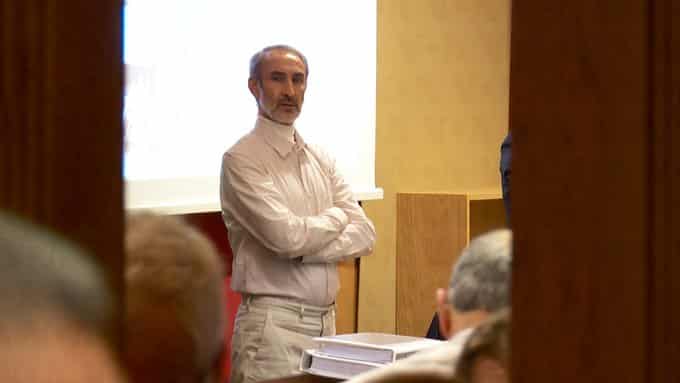85th Session of Hamid Noury’s Trial: Witness Recalls Defendant’s Role in the 1988 Massacre

Written by
Sedighe Shahrokhi
The eighty-fifth session of the trial of Hamid Noury, a former prison guard accused of contributing to the mass executions of political prisoners in Gohardasht Prison in the summer of 1988, was held on Wednesday, April 20. The witness, Alireza Omidmoaf, participated in the trial via direct video call from the Netherlands.
Responding to the prosecutor’s questions, the witness explained that he was arrested at his workplace in November 1985. According to his testimony, the witness was initially told he was arrested on narcotics-related charges, which was obviously a desperate attempt to cover up the real cause which was supporting the People’s Fedayeen Guerrilla Organization.
Omidmoaf was kept in the so-called Joint Committee for two or three months and then later transferred to Evin Prison. He was put in solitary confinement known as a “sanatorium” for four or five months. He was later taken to Ward 3 of this prison by mid-1986 and spent a total of a year and a half in that prison. A so-called court had then charged him with exposing the regime oppressing and exploiting workers, providing financial assistance, and working to overthrow the Islamic Republic, and sentenced him to two years imprisonment.
Omidmoaf testified that in 1987, he was transferred to Gohardasht Prison with all the prisoners in Ward 3 of Evin Prison. After two months and back in Evin Prison, the witness said that he was taken there to Ebrahim Raisi, who was then a deputy prosecutor. Ebrahim Raisi, who appeared in plain clothes at the meeting, asked him to express his disgust and reject affiliation with his organization and give an interview. Something that the witness refused to accept.
Omidmoaf was once again transferred to Gohardasht Prison in May 1988, where they were stripped naked and blindfolded, and punched by going through a human tunnel of the Revolutionary Guards. He and other leftist and “Melli-kesh” prisoners (inmates who were not released despite the end of their sentences) were separated from prisoners affiliated with the Mojahedin-e-Khalq (PMOI/MEK).
The witness said that the prisoners spread the news about the executions in the prison through the Morse code on August 31, 1988. The prisoners in the opposite ward told them that only the prisoners in their ward and ward 14 survived. On the morning of September 1, all the prisoners were taken out of the ward along with the witness himself. They were given forms to a piece of paper each to respond to ideological questions. There, the witness saw a person in charge of the questioning but did not recognize him.
Omidmoaf was beaten the same morning. “Be a man,” Mohammad Moghiseh (aka Naserian) had told him, grabbing the witness by the collar and beating him. “Say you are not a Muslim and that you denounce the regime.”
The witness remained silent. According to Mr. Omidmoaf, Naserian shook him hard and let him fall to the ground. The witness said he felt a foot on his neck. It was the foot of the same person who questioned the prisoners on the 9th day. Other prisoners later told him that this person was Hamid Noury.
Omidmoaf was released from Gohardasht Prison in March 1988 after the mass executions had ended.
The eighty-fifth session included some important margins as well. According to the media, Hamid Noury’s lawyers rejected the Swedish court’s jurisdiction and the laws handling Nouri’s case by presenting a case known as the “Lundin Case” in Sweden and comparing its details with Hamid Noury’s court.
Lundin Case is a case involving the Swedish oil company Lundin in Sudan, which has now been referred to the Swedish Supreme Court. Hamid Noury’s lawyers also told the court that it was not possible under Swedish law to try the execution of left-wing prisoners and the testimony of some left-wing prisoners saved from execution in a Swedish court.
85th Session of Hamid Noury’s Trial: Witness Recalls Defendant’s Role in the 1988 Massacre

